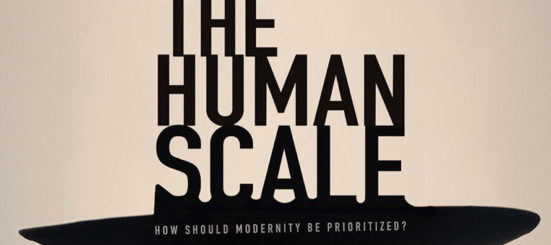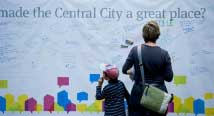Film Review: The Human Scale
February 25, 2014

“Fifty percent of the world’s population lives in cities. By 2050, it will be 80 percent.”
One of the opening lines of Danish architect Jan Gehl’s The Human Scale highlights how the design of our cities will impact more people’s lives than at any previous point in human history. A city’s design directly impacts its population’s health, happiness, and way of life.
The film visits various cities around the world and illustrates the value of urban planning and design by focusing on a specific problem arising from the growth in each. The cities shown range from New York City to Dhaka, Bangladesh to Chongqing, China, Melbourne, Australia, and Christchurch, New Zealand.
In Dhaka, industrialization and wealth are transforming policy to benefit the automobile at the expense of its lower income residents and the rickshaw, the traditional form of transport. Even when rickshaws were banned outright from the roadways in order to increase traffic flow, there is no noticeable change.
In contrast, New York City is in the process of creating public spaces out of excess pavement, with enormous success. The most recognizable example of this transformation is Times Square; a space formerly littered with fleets of taxis is now filled with pedestrians, both tourists and native New Yorkers alike. New York routinely tests potential improvements using temporary materials — in the case of Times Square, a tan-colored pavement and folding chairs – in order to examine the level of latent demand for a design before implementing the permanent change.
The city of Melbourne, which was suffering from a decline in population, revitalized its downtown and attracted new residents by setting new guidelines for its urban alleyways, making them much more inviting to pedestrians and encouraging open air restaurants and cafes.
The final case study explored in The Human Scale was how to rebuild Christchurch. The New Zealand city was struck by a magnitude 6.3 earthquake in 2011, killing 185 and causing critical structural damage to 1,000 buildings in the core of the city. As a result, much of the city needs to be rebuilt from the ground up in the coming years. Instead of replacing each building, a professional consortium of planners invited the community to participate in its Christchurch Central City Plan in order to create a new community that is designed for people.
The Human Scale urges that, as cities evolve, we need to design for people. A city designed around the scale of the automobile creates barriers between homes, offices, and meeting places for the city’s inhabitants. As cities grow larger and more complex, it is imperative that the scale of the city doesn’t grow with it. No matter the size, a city needs to provide a safe, healthy, and social lifestyle for its residents, workers, and visitors.
Is your community human-scaled? What do you love about your community? What would you change to make it more inviting?
View the trailer for The Human Scale: http://www.youtube.com/watch?v=BxywJRJVzJs


Leave a Comment